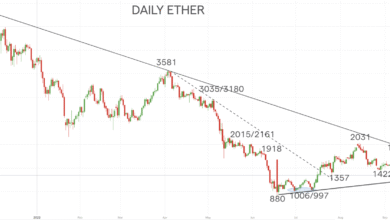Bitcoin Price Prediction: Will It Hit $10M Soon?

Bitcoin price prediction is an increasingly hot topic in the financial world, driven by insights from experts like Michael Saylor, who strongly believe that Bitcoin could reach unprecedented heights. Saylor’s forecast of a $10 million Bitcoin has raised eyebrows, especially considering the current restrictions placed by wealth management firms on Bitcoin exchange-traded funds (ETFs). As trillions remain inaccessible due to advisors’ hesitations, the call for broader Bitcoin institutional adoption grows louder. Financial advisors managing over $50 trillion are, according to recent studies, delaying their endorsement of Bitcoin until it’s substantially higher in price. Thus, the dialogue surrounding Bitcoin price prediction is not only about potential gains but also highlights significant systemic barriers that continue to hinder access and investment in this digital asset.
The future valuation of Bitcoin, often referred to as digital gold, is a subject of great speculation, especially among the investing community. With predictions like that of Michael Saylor, who suggests that Bitcoin could soar to a staggering $10 million, many are analyzing the market dynamics at play. The restrictive policies on Bitcoin ETFs by major financial institutions play a crucial role, limiting the opportunities for institutional investors. Wealth management firms are still adjusting to the inevitable push towards cryptocurrency adoption, and the hesitance seen from financial advisors may soon be a relic of the past. As discussions around digital currencies evolve, the prognostications regarding Bitcoin’s price trajectory are increasingly intertwined with the broader narrative of cryptocurrency’s integration into traditional financial systems.
Michael Saylor’s Bold Prediction on Bitcoin Value
Michael Saylor, the influential co-founder of MicroStrategy, has made waves in the cryptocurrency industry with his ambitious assertion that Bitcoin could soar to $10 million per coin. This forecast derives from his belief that as corporate and institutional investors continue to integrate Bitcoin into their balance sheets, the price will appreciate exponentially. Saylor argues that the current restrictions imposed by financial advisors serve as a temporary obstacle, preventing massive inflows of capital into Bitcoin. He asserts the urgency for these advisors to reconsider their stance on Bitcoin, as higher prices will soon dictate a change in investment strategy.
This assertion is not merely speculative; it is rooted in tangible market dynamics. Institutions, which control substantial capital, have been slow to adapt to the Bitcoin investment landscape due to the prevalent restrictions imposed by wealth management firms. Saylor’s prediction suggests that by the time these advisors acknowledge Bitcoin as a viable asset class, its value will have escalated to staggering heights. This could send a strong message to investors about the importance of acting decisively rather than relying solely on traditional financial advice.
The Impact of Bitcoin ETFs on Institutional Adoption
Bitcoin exchange-traded funds (ETFs) represent a significant advancement in making Bitcoin accessible to a broader base of investors, including those traditionally hesitant due to volatility. The approval of Bitcoin ETFs is a watershed moment for institutional adoption, yet many financial advisors cling to cautious narratives, restricting their clients’ access to this emerging asset. As noted by Saylor, the vast majority of financial assets are still tied up in firms that impose significant barriers to Bitcoin investments. This inertia could cost investors valuable opportunities as Bitcoin continues to gain recognition and legitimacy in the financial world.
The slow uptake of Bitcoin ETFs among wealth management firms speaks volumes about the limitations set by high-budget financial advisor firms with over $50 trillion in assets. Data illustrates that only a minority of these firms allow unrestricted investments in Bitcoin ETFs, further exhibiting a significant disconnect between market demand and advisor access. If these barriers were dismantled, capital flows could surge, leading to heightened institutional investment in Bitcoin and elevating its status as a staple asset in diversified portfolios.
Understanding Bitcoin’s Path Amidst Financial Advisor Hesitation
The substantial reluctance from financial advisors to recommend Bitcoin highlights the need for a paradigm shift within the wealth management sector. Saylor’s commentary illuminates a critical point of contention; as long as financial advisors maintain their restrictive policies, the broader adoption of Bitcoin will be stunted. This situation not only affects individual investors but also impacts the entire cryptocurrency ecosystem by preventing essential capital inflows that could stabilize and grow Bitcoin’s market presence.
Moreover, market critics often cite volatility as a reason for restraint, but history has shown that all emerging asset classes exhibit some level of uncertainty. As institutional investors like Michael Saylor advocate for embracing Bitcoin, the financial advisory sector must reevaluate their conservative stance. By resisting change, advisors may inadvertently prolong the window where Bitcoin remains an undervalued asset, pushing its true potential further from reach until it’s far too late.
The $1.56 Trillion Opportunity in Bitcoin Investment
Tephra Digital’s recent analysis reveals the staggering potential inherent in Bitcoin investment, especially concerning access to Bitcoin ETFs. Their findings suggest that if merely 5% of the capital locked in wealth management firms with restricted access were allocated to Bitcoin ETFs, a massive influx of approximately $1.56 trillion could be unleashed into the market. This figure underscores Michael Saylor’s prediction that Bitcoin’s value could skyrocket as institutional investors begin to engage with the asset class more freely.
This scenario is particularly compelling for financial advisors, who have the power to unlock such potential by altering their restrictive policies toward Bitcoin. Moving beyond traditional investment holdings to include Bitcoin could also ensure these advisors remain competitive in a rapidly evolving financial landscape. Each shift in access policies signals a broader understanding of Bitcoin’s role in portfolios, ultimately leading towards a path where financial advisors not only acknowledge Bitcoin but also endorse it as a primary investment vehicle.
Barriers to Entry: The Challenge of Restricted Access
The financial advisory ecosystem remains entrenched in traditional investment frameworks, often viewing Bitcoin as a speculative asset rather than a store of value. This mindset sustains significant barriers to entry for retail and institutional investors alike, limiting their exposure to Bitcoin ETFs. As a result, investors are left to navigate a complex landscape rife with uncertainty, with many opting to stay on the sidelines while waiting for their financial advisors to signal that Bitcoin is a sound investment.
Yet, these barriers are not insurmountable. As Saylor articulates, the imminent price increases of Bitcoin will soon invalidate the caution exercised by many financial advisors. A reconsideration of Bitcoin’s potential could lead to a new era of investment strategy that encompasses digital currencies and recognizes the importance of Bitcoin in a diversified investment portfolio. The call for action is clear: adapt to the evolving financial environment or risk becoming obsolete.
Navigating Financial Advisors and Bitcoin’s Future
As the dialogue around Bitcoin evolves, financial advisors face an increasingly pressing question: how to effectively guide their clients when traditional investment paradigms are challenged by emerging assets like Bitcoin? The evidence presented by thought leaders, such as Michael Saylor, advocates for a forward-thinking approach that acknowledges Bitcoin as a critical player in future financial markets. Financial advisors who recognize the value proposition of Bitcoin not only enhance their credibility but also empower their clients to capitalize on unprecedented investment opportunities.
This shift may require advisors to improve their understanding of Bitcoin and educate their customers about its potential risks and rewards. Embracing digital currency as part of a balanced financial strategy could prevent clients from missing out on the growth potential that Bitcoin offers. By staying informed and proactive, financial advisors can navigate discussions surrounding Bitcoin and position themselves as trusted sources in a rapidly changing investment landscape.
The Role of Regulatory Framework in Bitcoin Adoption
Regulatory clarity is paramount for the flourishing of Bitcoin ETFs and, consequently, for the institutional adoption of Bitcoin. As the market scrambles for compliance and legitimacy, financial advisors must grapple with the impact these regulations have on their recommendations to clients. Saylor’s assertion that Bitcoin’s value will spike as advisors begin to uplift their restrictions hints at the profound influence that regulatory frameworks exert on market psychology and investor confidence.
The current regulatory environment is a double-edged sword; while it poses challenges, it also offers as an opportunity for establishing guidelines that can facilitate greater capital inflows into the Bitcoin space. With increasing pressures for transparency and accountability, the financial sector may soon evolve to embrace Bitcoin with open arms, transforming skepticism into recognition of its rightful place in diversified investment strategies. The challenge remains for financial advisors to adapt to these changes and foster an understanding of Bitcoin within traditional investing paradigms.
Financial Advisors Preparing for the Bitcoin Boom
As Bitcoin continues to demonstrate resilience and growth, financial advisors must prepare for the forthcoming boom in Bitcoin adoption. This preparation involves not only adjusting their asset allocation strategies but also staying ahead of regulatory changes that could reshape the investment landscape. Advisors who take proactive steps to integrate Bitcoin into their practice will position themselves to capture a new market segment seeking exposure to cryptocurrencies.
The financial world is on the cusp of a dynamic shift, propelled by advocates like Michael Saylor and the undeniable draw of substantial wealth tied up in cryptocurrencies. Advisors who dismiss Bitcoin may find themselves left behind, as more forward-thinking firms begin to actively include cryptocurrencies in portfolios. By embracing this change and educating their clients, financial advisors can navigate the impending boom effectively while ensuring that their practices evolve in tandem with the burgeoning cryptocurrency market.
The Future of Bitcoin: Minimal Time Left for Advisors
The trajectory of Bitcoin suggests an imminent price increase, as the analysis by Tephra Digital illustrates the immense capital still to be unleashed upon regulatory leniency from financial advisors. Michael Saylor boldly asserts that the window for traditional financial advisors to embrace Bitcoin is rapidly closing, with significant consequences for those who choose to remain uninformed. As institutional interest expands, the urgency for advisors to adapt to this reality cannot be overstated.
Moreover, with the potential for Bitcoin to appreciate significantly in value, financial advisors must reevaluate their role in educating clients about Bitcoin investments. As the market matures, clients will expect their advisors to provide insights into this rapidly evolving asset class. Those who do not adapt may not only miss advising opportunities but could also find themselves at risk of losing clients to advisors who embrace innovation and change.
Frequently Asked Questions
What factors could contribute to Michael Saylor’s $10 million bitcoin prediction?
Michael Saylor’s prediction of a $10 million bitcoin is influenced by the slow adoption rate among financial advisors and institutional investors, as trillions remain locked behind advisor restrictions. This substantial capital could flow into bitcoin ETFs if access barriers were lifted, potentially driving the price much higher.
How does bitcoin institutional adoption affect bitcoin price predictions?
Bitcoin institutional adoption plays a crucial role in price predictions, as more investment from wealth management firms increases demand. Michael Saylor suggests that as financial advisors gradually recognize bitcoin’s value, prices could soar, aligning with predictions of $10 million per bitcoin as barriers to access are removed.
What role do bitcoin ETFs play in the future of bitcoin price prediction?
Bitcoin ETFs are pivotal to future price predictions, as they provide a regulated way for investors to gain exposure to bitcoin. The current restrictions imposed by financial advisors limit access, but as adoption increases, Saylor’s prediction of a $10 million bitcoin may become viable, reflecting significant capital inflows.
Why do financial advisors currently restrict access to bitcoin investments?
Financial advisors restrict access to bitcoin due to concerns about market volatility, regulatory complexities, and a lack of understanding of bitcoin’s potential. This caution is affecting predictions for bitcoin’s price, with experts like Michael Saylor asserting that understanding will evolve as advisors recognize bitcoin’s intrinsic value.
Will bitcoin reach $10 million if financial advisors begin to support bitcoin investments?
If financial advisors begin to support bitcoin investments, it could lead to substantial increases in demand, thereby driving the price towards the predicted $10 million range posited by Michael Saylor. As more advisors endorse bitcoin ETFs and educate clients, this shift may unlock significant capital currently restricted.
What is the potential impact of removing restrictions on bitcoin ETF access?
Removing restrictions on bitcoin ETF access could unleash trillions of dollars currently tied up in wealth management platforms. According to estimates, even a small shift allowing 1% of assets into bitcoin ETFs might lead to an influx of $312 billion, significantly affecting bitcoin price predictions and potentially validating forecasts like Michael Saylor’s $10 million bitcoin.
How likely is it for bitcoin to reach $10 million given current market conditions?
While market conditions introduce uncertainty, Michael Saylor’s prediction of a $10 million bitcoin relies on the eventual adoption by financial advisors and the lifting of restrictions on bitcoin ETFs. If these conditions materialize, the potential for dramatic price increases is plausible, fueled by institutional investments.
What should investors consider about Michael Saylor’s $10 million bitcoin prediction?
Investors should consider the implications of Michael Saylor’s $10 million bitcoin prediction in light of institutional adoption and current advisor restrictions. While ambitious, the prediction underscores the potential growth of bitcoin as market dynamics shift and more investment vehicles like ETFs become accessible.
| Key Point | Description |
|---|---|
| Michael Saylor’s Prediction | Saylor predicts Bitcoin could reach $10 million as financial advisors lag in advising investments. |
| Advisor Restrictions | $50 trillion in assets are managed by firms that restrict access to Bitcoin ETFs, limiting institutional investment. |
| Investment Potential | If just 5% of restricted assets were invested in Bitcoin ETFs, it could amount to $1.56 trillion. |
| Current State of Advisors | Only 38% of firms currently offer unrestricted access to Bitcoin ETFs. |
| Major Firms | Companies like Charles Schwab and Fidelity provide unrestricted ETF access, managing $19.1 trillion. |
| Critics vs. Advocates | Critics cite market volatility, while advocates argue for removing access barriers to promote adoption. |
Summary
Bitcoin price prediction suggests significant potential growth as Michael Saylor forecasts a $10 million valuation. The current restrictions imposed by financial advisors on Bitcoin ETF investments indicate a substantial lag in institutional adoption. However, the possibility of unlocking trillions in assets could lead to increased investment flows if these restrictions are eased. As the landscape evolves, the overall willingness of financial advisors to embrace Bitcoin will significantly influence future price trajectories.




